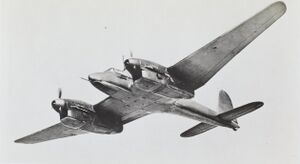Nikita NB-160 Durva
Jump to navigation
Jump to search
| Nikita NB-160 Durva | |
|---|---|

| |
| Role | Heavy Bomber |
| National origin | Tennai |
| Manufacturer | Nikita Aircraft |
| Designer | Kapishan Mishaani |
| First flight | February 1934 |
| Introduction | July 1935 |
| Retired | 1955 |
| Status | Retired |
| Primary user | Royal Tennaiite Air Force |
| Produced | 1935-1950 |
The Nikita NB-160 Durva was a four-engined heavy bomber developed in the 1930s for the Royal Tennaiite Air Force.
Development
Design and Variants
Operational History
Siduri War
Operators
Specifications (NB-160 A1)
General characteristics
- Crew: 10 ( Pilot, co-pilot, navigator, bombardier/nose gunner, flight engineer/top turret gunner, radio operator, waist gunners (2), ball turret gunner, tail gunner)
- Length: 35 m (114 ft 10 in)
- Wingspan: 43 m (141 ft 1 in)
- Height: 5.5 m (18 ft 1 in)
- Wing area: 161.3 m2 (1,736 sq ft)
- Empty weight: 14,500 kg (31,967 lb)
- Gross weight: 5,000 kg (11,023 lb)
- Max takeoff weight: 47,600 kg (104,940 lb) 42840
- Powerplant: 4 × Kamala TU-1710 V-12 inverted liquid-cooled piston engines 1,115 PS (820 kW; 1,100 hp)
- Propellers: 4-bladed constant-speed propellers
Performance
- Maximum speed: 402 km/h (250 mph; 217 kn) at 7,000 m (22,966 ft)
- Cruise speed: 322 km/h (200 mph; 174 kn)
- Stall speed: 105 km/h (65 mph; 57 kn)
- Range: 8,047 km (5,000 mi; 4,345 nmi)
- Combat range: 4,828 km (3,000 mi; 2,607 nmi)
- Service ceiling: 7,315 m (23,999 ft)
- Rate of climb: 24 m/s (4,700 ft/min)
- Time to altitude: 6,000 m (19,685 ft) in 5 minutes 12 seconds
Armament
- Guns:
- 6 × 7.62 mm (0.300 in) Basu HV 82 machine guns in fuselage sides
- 4 × 12.72 mm (0.501 in) Basu FG 20-20 cannon in lower fuselage
- Bombs
- Up to 5,520 kg (12,170 lb) bombs